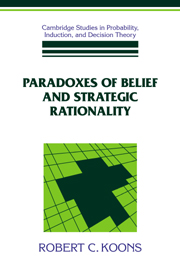Appendix C - On schematic generalization
Published online by Cambridge University Press: 06 January 2010
Summary
The solution to liar-like paradoxes developed in Chapters 5 and 7 depends on a kind of context-sensitive limitation on the expressiveness of natural language. It has often been argued that the postulation of such limitations is self-defeating, since the theory being proposed cannot, by its own lights, be expressed with sufficient generality. I hope to show that this objection can be met by proposing a distinction between two kinds of generality: schematic and quantificational.
I begin with an objection to Burge' s solution posed by D. A. Martin. Although we cannot express higher-order liars in natural language, we certainly can do so by means of explicit quantification over Burgean propositions. We can, for instance, construct a self-referential proposition (λ1):
(λ1) ¬ true1(λ1).
(λ1) says, in effect, that (λ1) is not true1. This proposition is untrue1 and true2. Similarly, for each ordinal a, there is a liar proposition λa. We can introduce a function term ‘λ(x)’, designating, for each ordinal a, the liar λa. Now consider the token (A):
(A)∀x ∈ ON true(λ(x)).
Each liar λa is truea+1 but there is no level at which all are true. How, then, can we interpret the occurrence of the predicate ‘true’ in (A)?
The problem, of course, is that, in interpreting (A), we want to use a level that is the ordinal of the class of ordinals. The idea that there is an ordinal of the class of ordinals can be shown to be inconsistent; in fact, this was the first of the set-theoretic paradoxes to be discovered, the Burali–Forti paradox. Thus, in order to solve Martin's problem, something must be said about the solution to the set-theoretic paradoxes in intensional contexts.
- Type
- Chapter
- Information
- Paradoxes of Belief and Strategic Rationality , pp. 160 - 165Publisher: Cambridge University PressPrint publication year: 1992



